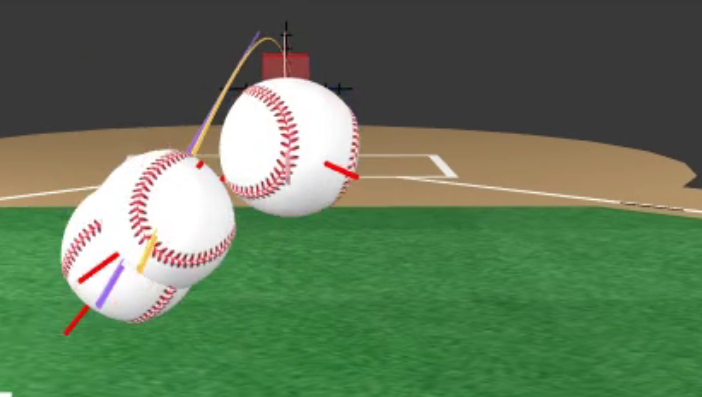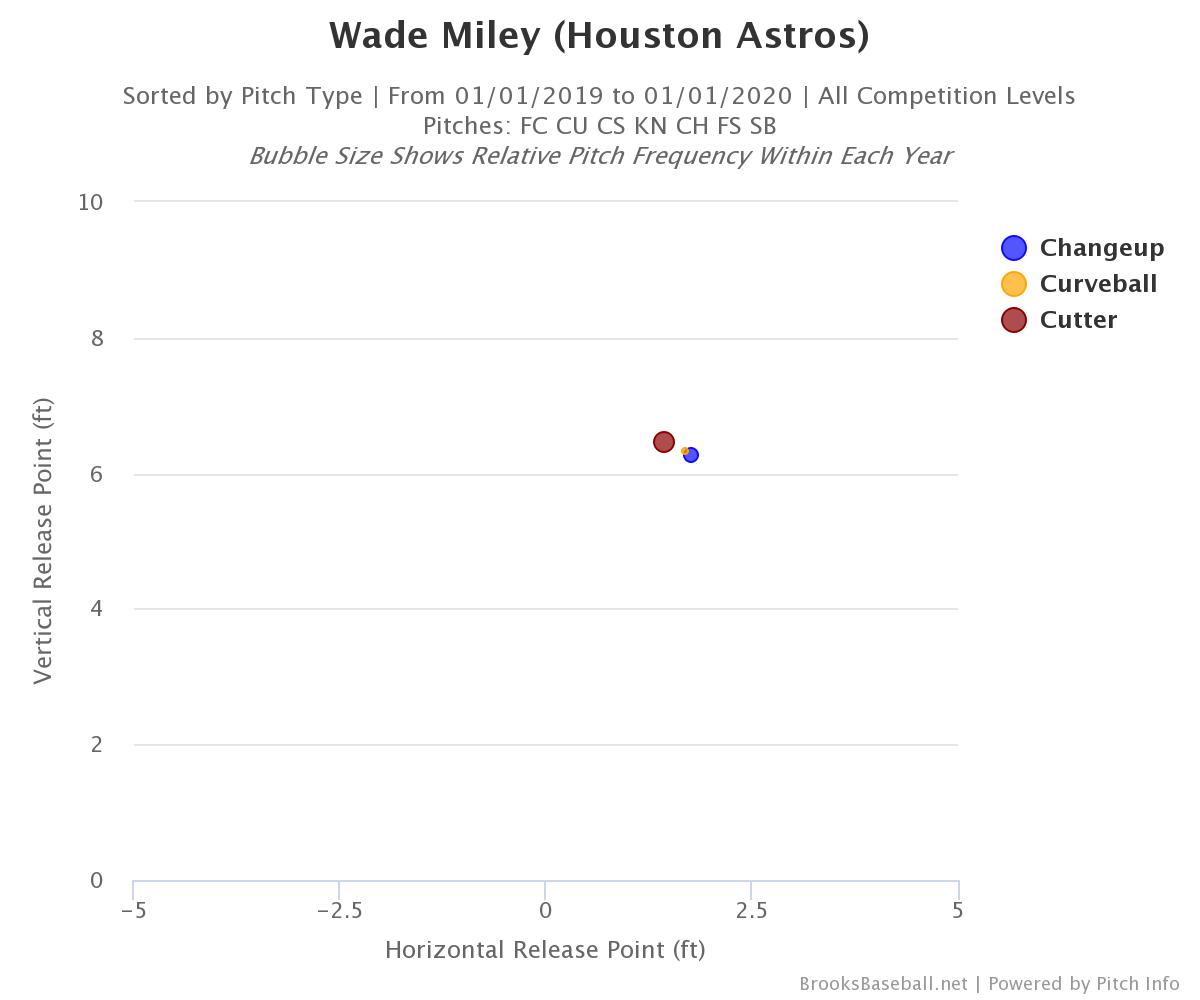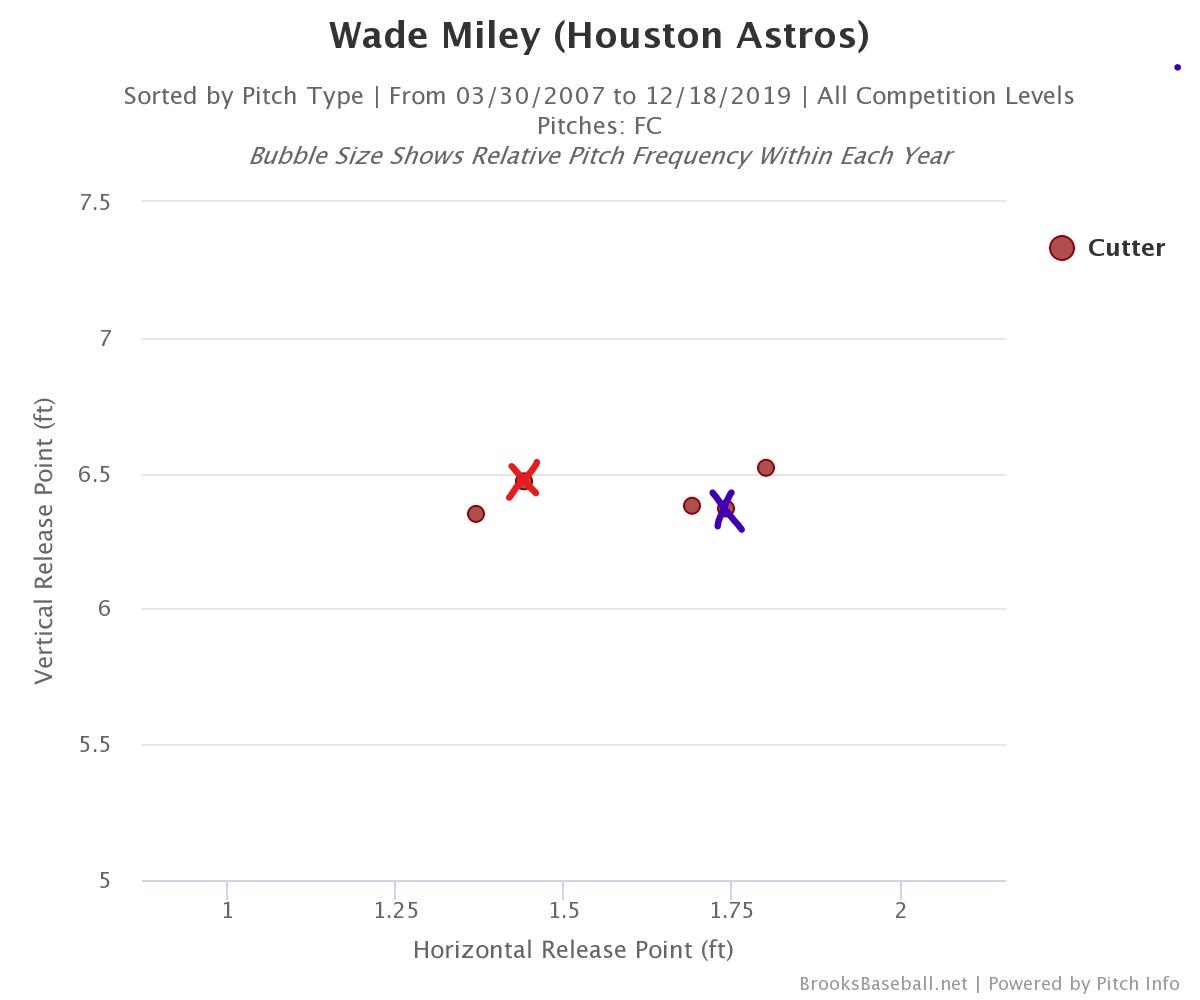Wade Miley’s Cutter Should Be a Lot Better
Veteran southpaw Wade Miley recently signed a two-year deal with the pitching-minded Cincinnati Reds. Last year with the Houston Astros, Miley posted his highest WAR since 2015, which should come as little surprise since he was under the guidance of one of the best pitching coaches in baseball, Brent Strom, though he ended the year on a sour note. While he’s likely in the twilight of his career, the 33-year-old will once again be working with another elite pitching coach, Derek Johnson. What kind of production might the Reds see from Miley in 2020? While I’m sure the folks in Great American Ballpark have their ideas, I see a basic change to his favored pitch, the cutter, which could help Miley in the long run.
Miley generally works with four pitches: a backspin cutter (his main pitch), a circle change, a four-seamer, and a lightly used curveball.
Notice anything in the above GIF? A quick inspection of the arm-slot pause shows a decent amount of release point variation between Miley’s cutter (and, to a lesser extent, his four-seamer) compared to his changeup and curve. Since Miley’s cutter usage is on the rise, we’ll focus on that pitch and, for the sake of argument, ignore the four-seamer; that version of his fastball has been on a steady decline, though there was a slight uptick in its use last year.
Have a look at an up-close plotting of the cutter (top right) with the changeup and curve under their 2019 average release points:

The extent to which this actually matters to a hitter is the subject of debate, but one thing is certain: Miley’s cutter didn’t perform well in 2019. According to MLB QOPA, in a vacuum, the pitch is actually good; they rate it a 5.03, which is considered good quality. (Their metric factors in both horizontal and vertical break along with where said break actually occurs in the pitch trajectory, as well as where the pitch is typically located and the effectiveness in that zone). Obviously, any system can be flawed in various ways and other forms of data need to be taken into consideration as well; this is strictly looking at the pitch from a design perspective.
FanGraphs Pitch Info Pitch Value (which adds further context to the pitch outside of how it acts) was a little more bearish on 2019’s cutter, rating it a -0.03 when scaled to 100 pitches.
Using Alex Chamberlain’s terrific Pitch Outcome leaderboards, Miley’s cutter produced a FIP of 5.26, a wOBA of .344, and a K-BB% of just 7.5%, the worst of all pitches of his thrown at least 200 times. Its effectiveness went in and out for most of the 2019 season, with a major disruption of performance occurring in August-October.
We have a good pitch in principle, but the numbers tell us it wasn’t in practice, which means Miley either wasn’t using it properly (perhaps it was sequenced poorly), or there was something hitters were picking up that gave them an advantage.
Ken Rosenthal recently wrote a piece for The Athletic that points out Miley was perhaps tipping his pitches, not only during the Division Series against the Rays but at the end of the 2019 season as well. With clear differences between where Miley held the ball, it could have cued hitters as to what he had in store for them.
Yet there’s one other factor in play that may have prevented Miley from taking full advantage of his cutter’s potential in 2019: the aforementioned identifiable arm slot disparity.
Here’s a freeze-frame look at his arm slots on release:

Here we see the clear difference in Miley’s release points. He uses more of an over-the-top motion for his cutter (and four-seamer), while his changeup and curve are close to a three-quarter slot. The initial inspection of the picture above might lead one to assume that in order to fix Miley’s arm slot, he needs to make an adjustment to his lateral trunk tilt. However, I’m thinking that the “ghost images” (the lightened portion of the overlay) have more to do with where he happened to throw from on the mound in this instance than an issue with body mechanics.
Regardless of whether Miley ought to address the trunk tilt or only his arm slot, his release point should be lowered. This is apparent when we look at his 2019 release chart:

Using the Driveline Edge tool, we can see, as referenced in the earlier image, how Miley’s cutter, changeup, and curveball work together under their actual average release points:
For Miley’s release points to match more closely, he’d need to move his horizontal release out at least three-and-a-half inches, and lower it by a more than two inches from where he threw it last year.
That sounds easy and it actually might be; Miley has thrown from that angle before. Looking at his historical cutter release points, his 2017 average (marked with the blue X) is almost exactly where he’d want it to be based on where he threw his secondary pitches last season:

If Miley is able to make that adjustment, here’s how the three would look together:
A minor byproduct of this change could be that Miley potentially adds an additional inch of rise to the cutter. Chances are, if he is able to drop his arm slot to the preferred location, it may end up having a small impact on the spin efficiency of the cutter, which is the corollary of a slightly altered gyro degree coming out of Miley’s hand:
Miley’s cutter could become a casualty if it can’t recover from whatever caused its faults in 2019, whether it was the apparent tipping his pitches or hitters picking up on his arm slot too easily. Regardless of the cause, something will need to change if he plans to keep the pitch as a mainstay in his arsenal. Fixing the problems with his pre-windup should be easy. The other factor at play — his arm slot variance — should be as well.
According to Baseball Prospectus‘ tunneling metrics, Miley was able to pair and tunnel his cutter with his changeup and curve, but his release points are less than ideal. Fixing the arm slot might help tighten those numbers and make him an even better tunneler. In 2019, Miley ranked 83rd in overall PreMax (how close back-to-back pitches are at the hitter commit point), of pitchers who threw at least 150 dual-pitch sequences.
Making an adjustment to where Miley is releasing his cutter may help make his pitches harder for a hitter to distinguish, as demonstrated by the adjusted three-pitch graphic. Coupled with an awareness of possible pitch-tipping behavior, his arm slot change could help him squeeze a couple more productive years for the Reds.
Pitching strategist. Driveline Baseball pitch design-certified. Systems Administrator for a high school by day, I also provide ESPN with pitching visuals and am the site manager for SB Nation's Bucs Dugout.

Given the general visual acuity and pattern recognition that major league hitters generally need in order to be successful, I have to imagine that the hitters who are less “instinctual” (i.e. “see ball, hit ball”) and have success based more on scouting would be the type to benefit most from these discrepancies in pitch delivery.
I wonder if it would even be possible to identify those hitters other than flat-out asking them.
Since we have the tunneling stats and recognition stats we could find which hitters do well against pitchers who are poor at those metrics. But there would be small sample there so it might not be reliable for one year.